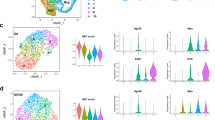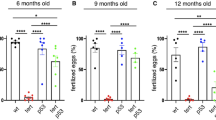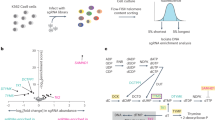Abstract
Telomere shortening limits the proliferative lifespan of human cells by activation of DNA damage pathways, including upregulation of the cell cycle inhibitor p21 (encoded by Cdkn1a, also known as Cip1 and Waf1)) (refs. 1–5). Telomere shortening in response to mutation of the gene encoding telomerase is associated with impaired organ maintenance and shortened lifespan in humans6 and in mice7,8,9. The in vivo function of p21 in the context of telomere dysfunction is unknown. Here we show that deletion of p21 prolongs the lifespan of telomerase-deficient mice with dysfunctional telomeres. p21 deletion improved hematolymphopoiesis and the maintenance of intestinal epithelia without rescuing telomere function. Moreover, deletion of p21 rescued proliferation of intestinal progenitor cells and improved the repopulation capacity and self-renewal of hematopoietic stem cells from mice with dysfunctional telomeres. In these mice, apoptotic responses remained intact, and p21 deletion did not accelerate chromosomal instability or cancer formation. This study provides experimental evidence that telomere dysfunction induces p21-dependent checkpoints in vivo that can limit longevity at the organismal level.
This is a preview of subscription content, access via your institution
Access options
Subscribe to this journal
Receive 12 print issues and online access
$209.00 per year
only $17.42 per issue
Buy this article
- Purchase on Springer Link
- Instant access to full article PDF
Prices may be subject to local taxes which are calculated during checkout





Similar content being viewed by others
References
Wright, W.E. & Shay, J.W. The two-stage mechanism controlling cellular senescence and immortalization. Exp. Gerontol. 27, 383–389 (1992).
Allsopp, R.C. et al. Telomere length predicts replicative capacity of human fibroblasts. Proc. Natl. Acad. Sci. USA 89, 10114–10118 (1992).
d'Ad da di Fagagna, F. et al. A DNA damage checkpoint response in telomere-initiated senescence. Nature 426, 194–198 (2003).
Brown, J.P., Wei, W. & Sedivy, J.M. Bypass of senescence after disruption of p21CIP1/WAF1 gene in normal diploid human fibroblasts. Science 277, 831–834 (1997).
Herbig, U., Jobling, W.A., Chen, B.P., Chen, D.J. & Sedivy, J.M. Telomere shortening triggers senescence of human cells through a pathway involving ATM, p53, and p21(CIP1), but not p16(INK4a). Mol. Cell 14, 501–513 (2004).
Vulliamy, T. et al. Disease anticipation is associated with progressive telomere shortening in families with dyskeratosis congenita due to mutations in TERC. Nat. Genet. 36, 447–449 (2004).
Rudolph, K.L. et al. Longevity, stress response, and cancer in aging telomerase-deficient mice. Cell 96, 701–712 (1999).
Herrera, E. et al. Disease states associated with telomerase deficiency appear earlier in mice with short telomeres. EMBO J. 18, 2950–2960 (1999).
Hao, L.Y. et al. Short telomeres, even in the presence of telomerase, limit tissue renewal capacity. Cell 123, 1121–1131 (2005).
Lombard, D.B. et al. DNA repair, genome stability, and aging. Cell 120, 497–512 (2005).
Lieber, M.R. & Karanjawala, Z.E. Aging, repetitive genomes and DNA damage. Nat. Rev. Mol. Cell Biol. 5, 69–75 (2004).
Min, H., Montecino-Rodriguez, E. & Dorshkind, K. Effects of aging on early B- and T-cell development. Immunol. Rev. 205, 7–17 (2005).
Lipschitz, D.A., Udupa, K.B., Milton, K.Y. & Thompson, C.O. Effect of age on hematopoiesis in man. Blood 63, 502–509 (1984).
Nishimura, E.K., Granter, S.R. & Fisher, D.E. Mechanisms of hair graying: incomplete melanocyte stem cell maintenance in the niche. Science 307, 720–724 (2005).
Wagers, A.J. & Conboy, I.M. Cellular and molecular signatures of muscle regeneration: current concepts and controversies in adult myogenesis. Cell 122, 659–667 (2005).
Lechel, A. et al. The cellular level of telomere dysfunction determines induction of senescence or apoptosis in vivo. EMBO Rep. 6, 275–281 (2005).
Lee, H.W. et al. Essential role of mouse telomerase in highly proliferative organs. Nature 392, 569–574 (1998).
Chin, L. et al. p53 deficiency rescues the adverse effects of telomere loss and cooperates with telomere dysfunction to accelerate carcinogenesis. Cell 97, 527–538 (1999).
Artandi, S.E. et al. Telomere dysfunction promotes non-reciprocal translocations and epithelial cancers in mice. Nature 406, 641–645 (2000).
Blasco, M.A. et al. Telomere shortening and tumor formation by mouse cells lacking telomerase RNA. Cell 91, 25–34 (1997).
Deng, C., Zhang, P., Harper, J.W., Elledge, S.J. & Leder, P. Mice lacking p21CIP1/WAF1 undergo normal development, but are defective in G1 checkpoint control. Cell 82, 675–684 (1995).
Hemann, M.T., Strong, M.A., Hao, L.Y. & Greider, C.W. The shortest telomere, not average telomere length, is critical for cell viability and chromosomal stability. Cell 107, 67–77 (2001).
Sudo, K., Ema, H., Morita, Y. & Nakauchi, H. Age associated characteristics of murine haematopoietic stem cells. J. Exp. Med. 192, 1273–1280 (2000).
Cheng, T. et al. Haematopoeitic stem cell quiescence maintained by p21Waf1/Cip1. Science 287, 1804–1808 (2000).
Rudolph, K.L. et al. Telomere dysfunction and evolution of intestinal carcinoma in mice and humans. Nat. Genet. 28, 155–159 (2001).
Greenberg, R.A. et al. Short dysfunctional telomeres impair tumorigenesis in the INK4a(delta2/3) cancer-prone mouse. Cell 97, 515–525 (1999).
Carnero, A. & Beach, D.H. Absence of p21WAF1 cooperates with c-myc in bypassing Ras-induced senescence and enhances oncogenic cooperation. Oncogene 23, 6006–6011 (2004).
Prowse, K.R. & Greider, C.W. Developmental and tissue-specific regulation of mouse telomerase and telomere length. Proc. Natl. Acad. Sci. USA 92, 4818–4822 (1995).
Randall, T.D. & Weissman, I.L. Characterization of a population of cells in the bone marrow that phenotypically mimics hematopoietic stem cells: resting stem cells or mystery population? Stem Cells 16, 38–48 (1998).
Satyanarayana, A. et al. Telomere shortening impairs organ regeneration by inhibiting cell cycle re-entry of a subpopulation of cells. EMBO J. 22, 4003–4013 (2003).
Acknowledgements
We thank P. Leder (Department of Genetics, Harvard Medical School) for providing Cdkn1a knockout mice. We thank R. Greenberg and N. Bardeesy for critical discussion and M. Ballmaier (Cell Sorting Core Facility, Hannover Medical School) for cell sorting. K.L.R. is supported by the Deutsche Forschungsgemeinschaft (Heisenberg Professorship: Ru 745/8-1, Ru745 4-1 and KFO119) and the Deutsche Krebshilfe e.V. (10-2236-Ru 2) as well as the Roggenbuck Foundation, the Wilhelm Sander Foundation and the Fritz Thyssen Foundation. H.W.L. was supported by grants from the 21C Frontier Functional Human Genome Project (FG05-22-02) and the BRC Frontier (M103KV010018-05K2201-01830).
Author information
Authors and Affiliations
Contributions
A.R.C., Z.J., A.L., S.S., A. Stepczynska, H.J., C.W., J.B., Tv.Z., A.G., P.S. and H.N. performed phenotype assessment of aging mice; M.W.D., A. Schienke and H.W.L. generated mouse crosses; A.R.C., Z.J., P.S. and H.N. contributed to writing the paper and K.L.R. designed the studies and wrote the paper.
Corresponding author
Ethics declarations
Competing interests
The authors declare no competing financial interests.
Supplementary information
Supplementary Fig. 1
p21 deletion does not rescue critical telomere shortening in iG4mice. (PDF 17 kb)
Supplementary Fig. 2
The reduced lifespan of telomere dysfunctional mice is not associated with impaired organ maintenance at a young age. (PDF 56 kb)
Supplementary Fig. 3
The reduction in function and maintenance of hematopoietic and intestinal stem and progenitor cells in telomere dysfunctional mice is age dependent. (PDF 47 kb)
Supplementary Fig. 4
Absence of widespread accumulation of SA-bGal-positive cells in different organs of aged iG4 mice. (PDF 108 kb)
Supplementary Fig. 5
p21-independent apoptosis in aging telomere-dysfunctional mice. (PDF 86 kb)
Supplementary Table 1
The prevalence and severity of colonic crypt dysplasia for individual mice analyzed at a histological level in 12- to 15-month-old mice. (PDF 22 kb)
Rights and permissions
About this article
Cite this article
Choudhury, A., Ju, Z., Djojosubroto, M. et al. Cdkn1a deletion improves stem cell function and lifespan of mice with dysfunctional telomeres without accelerating cancer formation. Nat Genet 39, 99–105 (2007). https://doi.org/10.1038/ng1937
Received:
Accepted:
Published:
Issue Date:
DOI: https://doi.org/10.1038/ng1937
This article is cited by
-
Telomeres, cellular senescence, and aging: past and future
Biogerontology (2024)
-
The meaning of adaptation in aging: insights from cellular senescence, epigenetic clocks and stem cell alterations
Nature Aging (2023)
-
Epigenetic reversal of hematopoietic stem cell aging in Phf6-knockout mice
Nature Aging (2022)
-
In vitro generation of transplantable insulin-producing cells from canine adipose-derived mesenchymal stem cells
Scientific Reports (2022)
-
ATP-dependent chromatin remodelers in ageing and age-related disorders
Biogerontology (2021)



